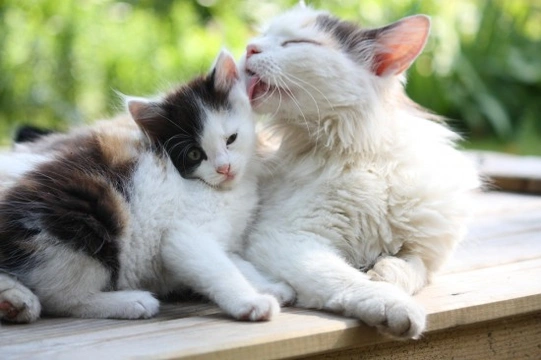
Your cat’s age in human years
It is entirely understandable for cat owners to find value in drawing parallels between the age of their cat and the approximate equivalent in human terms, in order to try to gain a deeper understanding of the life stages of the cat and their specific needs, developmental stage, likely health and potential longevity.
One figure that is commonly bandied about for cats (and dogs) is that if you multiply the age of the cat by seven, you will be able to reach the approximation of what their age would be if they were human. This is often taken as fact and not really thought about, but it is also pretty inaccurate! Cats can live for over 20 years, and following that formula, a 20 year old cat would be comparable to a person of 140 years old; and people simply do not live to 140 years old at all, never mind with any regularity!
Converting your cat’s age into approximate human years is an inexact science at best, and should be considered as something that is elastic and plotted on a curved scale, rather than being an easy to follow ratio of years and multiples.
With this in mind, here is our list of approximate cat age to human age comparisons, and what you can expect from your cat’s life stage.
Cat age: 3 months
Human age: 1 year
At this age, both kittens and babies will be (or can safely be) weaned and able to eat solid foods. The personalities of both baby and kitten are beginning to develop and be noticeable to their caregivers, and they begin to become less reliant on their mothers for constant care.
Cat age: 4 months
Human age: 2-3 years
Welcome to the toddler phase! Children begin to talk, investigate their worlds and develop their natural curiosity, and begin to separate themselves from their Mothers and see themselves as independent entities. Kittens begin to explore the world around them and test out the limitations of their environment, and both child and kitten will be highly active and into everything!
Cat age: 6 months-1 year
Human age: 12-15
This age can be considered to be the early teenage phase in cats, when sexual maturity is achieved although the cat is still immature and not considered fully grown or adult.
Cat age: 2
Human age: Early 20’s
Cat and person are both now young adults, fully grown and independent, and capable both physically and emotionally of raising families of their own.
Cat age: 3-6
Human age: Late 20’s-40
Both cat and person are at the physical peak of their lives, and notwithstanding any illnesses or accidents, in excellent physical health and fitness.
Cat age: 7-9
Human age: 40-mid 50’s
At this age, people are considered to be middle aged, and cats become classed as “mature.” Generally both people and cats will remain relatively physically fit and healthy at this stage, although the risks of various aging related health conditions and diseases are slightly elevated. The body and mind begin the very slow and gradual process of natural decline from this age onwards, which must be accounted for in terms of feeding and care of the cats in question.
Cat age: 9-13
Human age: Mid 50’s- early 60’s
Retirement and menopause loom for people, while for cats, they will naturally begin to take life easier, become less active and spend more time asleep. While cats generally remain active into old age, they are less likely from this point onwards to be particularly interested in long bouts of physical activity, and their natural hunting instincts begin to decline.
Age-related health problems such as arthritis and kidney issues may begin to manifest in cats.
Cat age: 13-17
Human age: 65-85
Signs of senility may begin to set in, and both people and cats may begin to lose some of their mental acuity to some degree. The senses begin to decline and become less acute, the organs become less efficient and may be prone to problems, and injuries take longer to heal. Both cat and person may be more prone to contracting minor illnesses and infections, as their immune systems begin to degrade.
Cat age: 17-19
Human age: 85-95
Both cat and person will be rather frail and delicate, and may begin to display changes in build and weight as the metabolism and thyroid function declines. Bone density is lost, and both cats and people become more prone to injury from minor bumps and accidents. Hearing and vision begin to fail, and memory, mental acuity and alertness decline pronouncedly.
Cat age: 20 or over
Human age: Over 95
Over 20 years old for cats or over 95 for people is a figure that is not commonly reached, although there are of course many exception is both the human and feline world! Take special care of your feline OAP if they make it to this grand old age, and do what you can to make life as comfortable and easy for them as possible. The oldest cats verified on record have lived to their mid 30’s, so while it is unlikely, you might find that your cat is still with you for several more years to come.



